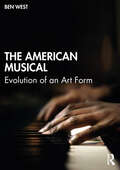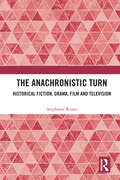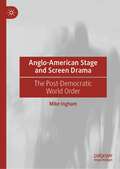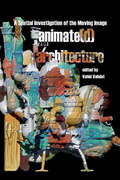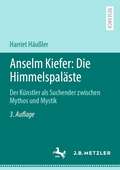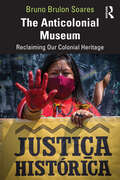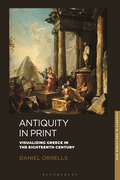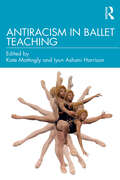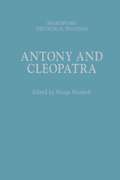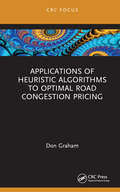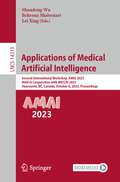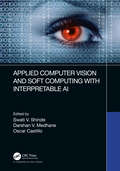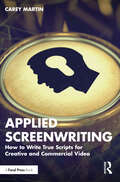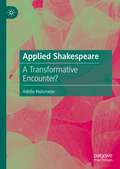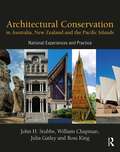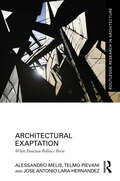- Table View
- List View
The American Musical: Evolution of an Art Form
by Ben WestThe American Musical is a comprehensive history of an American art form. It delivers a detailed and definitive portrait of the American musical’s artistic evolution over the course of seven distinct, newly defined eras, with a unique perspective gleaned from research at more than twenty different archives across the United States.Individual in both its approach and coverage, The American Musical traces the form’s creative journey from its 19th century beginnings, through its 20th century maturation, and to the turn of the 21st century, shedding new light on a myriad of authors, directors, and craftspeople who worked on Broadway and beyond. This book actively addresses the form’s often overlooked female and African-American artists, provides an in-depth accounting of such outside influences as minstrelsy, vaudeville, nightclubs, and burlesque, and explores the dynamic relationship between the form and the consciousness of its country.The American Musical is a fascinating and insightful read for students, artists, and afficionados of the American musical, and anyone with an interest in this singular form of entertainment.
The American Musical: Evolution of an Art Form
by Ben WestThe American Musical is a comprehensive history of an American art form. It delivers a detailed and definitive portrait of the American musical’s artistic evolution over the course of seven distinct, newly defined eras, with a unique perspective gleaned from research at more than twenty different archives across the United States.Individual in both its approach and coverage, The American Musical traces the form’s creative journey from its 19th century beginnings, through its 20th century maturation, and to the turn of the 21st century, shedding new light on a myriad of authors, directors, and craftspeople who worked on Broadway and beyond. This book actively addresses the form’s often overlooked female and African-American artists, provides an in-depth accounting of such outside influences as minstrelsy, vaudeville, nightclubs, and burlesque, and explores the dynamic relationship between the form and the consciousness of its country.The American Musical is a fascinating and insightful read for students, artists, and afficionados of the American musical, and anyone with an interest in this singular form of entertainment.
The Anachronistic Turn: Historical Fiction, Drama, Film and Television
by Stephanie RussoThe Anachronistic Turn: Historical Fiction, Drama, Film and Television is the first study to investigate the ways in which the creative use of anachronism in historical fictions can allow us to rethink the relationship between past and present. Through an examination of literary, cinematic, and popular texts and practices, this book investigates how twenty-first century historical fictions use creative anachronisms as a way of understanding modern issues and anxieties. Drawing together a wide range of texts across all forms of historical fiction - novels, dramas, musicals, films and television - this book re-frames anachronism not as an error, but as a deliberate strategy that emphasises the fictionalising tendencies of all forms of historical writing. The book achieves this by exploring three core themes: the developing trends in the twenty-first century for creators of historical fiction to include deliberate anachronisms, such as contemporary references, music, and language; the ways in which the deliberate use of anachronism in historical fiction can allow us to rethink the relationship between past and present, and; the way that contemporary historical fiction uses anachronism to better understand modern issues and anxieties. This book will appeal to students and scholars of historical fiction, contemporary historical film and television studies, and historical theatre studies.
The Anachronistic Turn: Historical Fiction, Drama, Film and Television
by Stephanie RussoThe Anachronistic Turn: Historical Fiction, Drama, Film and Television is the first study to investigate the ways in which the creative use of anachronism in historical fictions can allow us to rethink the relationship between past and present. Through an examination of literary, cinematic, and popular texts and practices, this book investigates how twenty-first century historical fictions use creative anachronisms as a way of understanding modern issues and anxieties. Drawing together a wide range of texts across all forms of historical fiction - novels, dramas, musicals, films and television - this book re-frames anachronism not as an error, but as a deliberate strategy that emphasises the fictionalising tendencies of all forms of historical writing. The book achieves this by exploring three core themes: the developing trends in the twenty-first century for creators of historical fiction to include deliberate anachronisms, such as contemporary references, music, and language; the ways in which the deliberate use of anachronism in historical fiction can allow us to rethink the relationship between past and present, and; the way that contemporary historical fiction uses anachronism to better understand modern issues and anxieties. This book will appeal to students and scholars of historical fiction, contemporary historical film and television studies, and historical theatre studies.
Anglo-American Stage and Screen Drama: The Post-Democratic World Order
by Mike InghamAnglo-American Stage and Screen Drama analyses and discusses the contemporary role of stage and screen drama as a critical forum for progressive thinking in an increasingly polarised geopolitical world. The book addresses the cultural politics of socially engaged 21st century stage plays and films, and makes the case for drama as a sociopolitical forum, in which the complex and contentious issues that confront society can be explored and debated. It conceives of Anglophone political drama as a significant intervention in today’s culture wars, representing the latter as a convenient distraction from the ongoing depredations of neoliberalism. In the main part of the book selected case-study plays and films from each of the first two decades illustrate drama’s capacity to influence critical debate on social justice issues. All of the case-study texts under discussion express a powerful aesthetics of resistance to right-wing ideology, and promote inclusive and enlightened values. This broader orientation underlines drama’s role as a channel for critical agency in today’s putative post-socialist, post-democratic climate.
Animate(d) Architecture: A Spatial Investigation of the Moving Image
by Vahid VahdatAt their peak, architectural marvels such as the Sagrada Família, the Tower of London, the Mosque–Cathedral of Córdoba, and the Eiffel tower, had a combined annual visit of almost 16.4 million people. The animated icebound castle in Disney’s (2019) Frozen had 116.4 million views, from one single YouTube trailer, in less than 24 hours. The spaces of such massively consumed animation have for generations informed the architectural imagination of people across the globe and from very early in their lives. Yet, not only have the architectural disciplines remained rather absent in the design of these massively consumed spaces, architectural theory has likewise failed to articulate a framework to approach the architecture of animation. To address this void, this book offers an interdisciplinary approach to survey the role of space in animation, including in creating humorous moments in early cartoon shorts, generating action and suspense in Japanese anime, and even stimulating erotic pleasure in pornographic Hentai. Exploring the imagined architecture of animation, from early motion picture to digital animation and from computer graphics to game engines, offers an analytical frame to reconceptualize space.
Anselm Kiefer: Der Künstler als Suchender zwischen Mythos und Mystik
by Harriet HäußlerDie Untersuchung der Himmelspaläste, mit denen Anselm Kiefer sein skulpturales Werk begründet, eröffnet einen vollkommen neuartigen Zugang zum Oeuvre des Künstlers. Aus der Betrachtung des Skulpturenzyklus´ konnte die Erkenntnis gewonnen werden, dass Kiefer keineswegs vorrangig als ein deutscher Künstler der Nachkriegszeit verstanden werden kann, der in seinen Werken vornehmlich Trauerarbeit und Vergangenheitsbewältigung leistet. Vielmehr ist er als ein bewusst selbstreflexiv arbeitender, künstlerischer Künstler zu bezeichnen, der sich bereits Jahre vor seinem Umzug nach Frankreich mit zahlreichen komplexen Themen, die nicht den nationalen bzw. den germanischen Themengebieten zuzurechnen sind, intensiv auseinandergesetzt hat.Anselm Kiefers Kunst verkörpert für Kiefer ein Reflexionsmedium, mit dessen Hilfe er sich selbst in der Welt situiert. Das Verhältnis zwischen Mikro- und Makrokosmos findet eine Entsprechung in Kiefers Verhältnis zu seinem eigenen Werk. Dieser als paradoxzu bezeichnende Bezug ist von Distanz und Nähe zugleich geprägt.
The Anticolonial Museum: Reclaiming Our Colonial Heritage
by Bruno Brulon SoaresThe Anticolonial Museum acknowledges some of the consequences of colonialism in the current work of museums. Looking at museum theory in a critical way, it proposes a radical revision of museums’ rhetoric on decolonisation, as well as their public image and practices. Bringing together a collection of reflections on decolonisation through the observation of museum performance and discourse, the author considers current practices in response to the social claims of marginalised groups and activists. Drawing from a genealogy of decolonial thinking in museology, Brulon Soares identifies the inherent paradoxes reflected in museum work. The book’s focus is not exclusively on the reality of colonised countries, nor on the context of former imperialist nations—instead, it raises anticolonial questions, finding common ground between the different actors involved in the museum: scholars, students, curators, practitioners, community members and Indigenous creators. One of the central aims of this book is to view the museum as a locus for multiple enunciations, thus identifying in museum practice the active possibility of reconnecting subjectivities and restoring material fluxes to effectively repair the bonds that have been frayed by colonialism and an expanding modernity. The Anticolonial Museum will be of great interest to researchers and students engaged in the study of decolonisation. It will also be essential for practitioners who wish to reconsider the impact of coloniality on their own position and everyday practice.
The Anticolonial Museum: Reclaiming Our Colonial Heritage
by Bruno Brulon SoaresThe Anticolonial Museum acknowledges some of the consequences of colonialism in the current work of museums. Looking at museum theory in a critical way, it proposes a radical revision of museums’ rhetoric on decolonisation, as well as their public image and practices. Bringing together a collection of reflections on decolonisation through the observation of museum performance and discourse, the author considers current practices in response to the social claims of marginalised groups and activists. Drawing from a genealogy of decolonial thinking in museology, Brulon Soares identifies the inherent paradoxes reflected in museum work. The book’s focus is not exclusively on the reality of colonised countries, nor on the context of former imperialist nations—instead, it raises anticolonial questions, finding common ground between the different actors involved in the museum: scholars, students, curators, practitioners, community members and Indigenous creators. One of the central aims of this book is to view the museum as a locus for multiple enunciations, thus identifying in museum practice the active possibility of reconnecting subjectivities and restoring material fluxes to effectively repair the bonds that have been frayed by colonialism and an expanding modernity. The Anticolonial Museum will be of great interest to researchers and students engaged in the study of decolonisation. It will also be essential for practitioners who wish to reconsider the impact of coloniality on their own position and everyday practice.
Antiquity in Print: Visualizing Greece in the Eighteenth Century (New Directions in Classics)
by Daniel OrrellsDaniel Orrells examines the ways in which the ancient world was visualized for Enlightenment readers, and reveals how antiquarian scholarship emerged as the principal technology for envisioning ancient Greek culture, at a time when very few people could travel to Greece which was still part of the Ottoman Empire. Offering a fresh account of the rise of antiquarianism in the 18th century, Orrells shows how this period of cultural progression was important for the invention of classical studies. In particular, the main focus of this book is on the visionary experimentalism of antiquarian book production, especially in relation to the contentious nature of ancient texts. With the explosion of the Quarrel between the Ancients and the Moderns, eighteenth-century intellectuals, antiquarians and artists such as Giambattista Vico, Johann Joachim Winckelmann, the Comte de Caylus, James Stuart, Julien-David Leroy, Giovanni Battista Piranesi and Pierre-François Hugues d'Hancarville all became interested in how printed engravings of ancient art and archaeology could visualize a historical narrative. These figures theorized the relationship between ancient text and ancient material and visual culture - theorizations which would pave the way to foundational questions at the heart of the discipline of classical studies and neoclassical aesthetics.
Antiracism in Ballet Teaching
by Kate Mattingly Iyun Ashani HarrisonThis new collection of essays and interviews assembles research on teaching methods, choreographic processes, and archival material that challenges systemic exclusions and provides practitioners with accessible steps to creating more equitable teaching environments, curricula, classes, and artistic settings. Antiracism in Ballet Teaching gives readers a wealth of options for addressing and dismantling racialized biases in ballet teaching, as well as in approaches to leadership and choreography. Chapters are organized into three sections - Identities, Pedagogies, and Futurities - that illuminate evolving approaches to choreographing and teaching ballet, shine light on artists, teachers, and dancers who are lesser known/less visible in a racialized canon, and amplify the importance of holistic practices that integrate ballet history with technique and choreography. Chapter authors include award-winning studio owners, as well as acclaimed choreographers, educators, and scholars. The collection ends with interviews featuring ballet company directors (Robert Garland and Alonzo King), world-renowned scholars (Clare Croft, Thomas F. DeFrantz, Brenda Dixon Gottschild), sought-after choreographers (Jennifer Archibald and Claudia Schreier), and beloved educators (Keesha Beckford, Tai Jimenez, and Endalyn Taylor). This is an essential resource for anyone teaching or learning to teach ballet in the Twenty First Century.
Antiracism in Ballet Teaching
by Kate Mattingly Iyun Ashani HarrisonThis new collection of essays and interviews assembles research on teaching methods, choreographic processes, and archival material that challenges systemic exclusions and provides practitioners with accessible steps to creating more equitable teaching environments, curricula, classes, and artistic settings. Antiracism in Ballet Teaching gives readers a wealth of options for addressing and dismantling racialized biases in ballet teaching, as well as in approaches to leadership and choreography. Chapters are organized into three sections - Identities, Pedagogies, and Futurities - that illuminate evolving approaches to choreographing and teaching ballet, shine light on artists, teachers, and dancers who are lesser known/less visible in a racialized canon, and amplify the importance of holistic practices that integrate ballet history with technique and choreography. Chapter authors include award-winning studio owners, as well as acclaimed choreographers, educators, and scholars. The collection ends with interviews featuring ballet company directors (Robert Garland and Alonzo King), world-renowned scholars (Clare Croft, Thomas F. DeFrantz, Brenda Dixon Gottschild), sought-after choreographers (Jennifer Archibald and Claudia Schreier), and beloved educators (Keesha Beckford, Tai Jimenez, and Endalyn Taylor). This is an essential resource for anyone teaching or learning to teach ballet in the Twenty First Century.
Antony and Cleopatra: Shakespeare: The Critical Tradition (Shakespeare: The Critical Tradition)
by Joseph Candido Professor Brian VickersThis new volume in the Shakespeare: The Critical Tradition series increases our knowledge of how Antony and Cleopatra has been received and understood by critics, editors and general readers. The volume provides, in separate sections, both critical opinions about the play across the centuries and an evaluation of their positions within and their impact on the reception of the play. The chronological arrangement of the text-excerpts engages the readers in a direct and unbiased dialogue, and the introduction offers a critical evaluation from a current stance, including modern theories and methods. This volume makes a major contribution to our understanding of the play and of the traditions of Shakespearean criticism surrounding it as they have developed from century to century.
Applications of Heuristic Algorithms to Optimal Road Congestion Pricing
by Don GrahamRoad congestion imposes major financial, social, and environmental costs. One solution is the operation of high-occupancy toll (HOT) lanes. This book outlines a method for dynamic pricing for HOT lanes based on non-linear programming (NLP) techniques, finite difference stochastic approximation, genetic algorithms, and simulated annealing stochastic algorithms, working within a cell transmission framework. The result is a solution for optimal flow and optimal toll to minimize total travel time and reduce congestion. ANOVA results are presented which show differences in the performance of the NLP algorithms in solving this problem and reducing travel time, and econometric forecasting methods utilizing vector autoregressive techniques are shown to successfully forecast demand. The book compares different optimization approaches It presents case studies from around the world, such as the I-95 Express HOT Lane in Miami, USA Applications of Heuristic Algorithms to Optimal Road Congestion Pricing is ideal for transportation practitioners and researchers.
Applications of Heuristic Algorithms to Optimal Road Congestion Pricing
by Don GrahamRoad congestion imposes major financial, social, and environmental costs. One solution is the operation of high-occupancy toll (HOT) lanes. This book outlines a method for dynamic pricing for HOT lanes based on non-linear programming (NLP) techniques, finite difference stochastic approximation, genetic algorithms, and simulated annealing stochastic algorithms, working within a cell transmission framework. The result is a solution for optimal flow and optimal toll to minimize total travel time and reduce congestion. ANOVA results are presented which show differences in the performance of the NLP algorithms in solving this problem and reducing travel time, and econometric forecasting methods utilizing vector autoregressive techniques are shown to successfully forecast demand. The book compares different optimization approaches It presents case studies from around the world, such as the I-95 Express HOT Lane in Miami, USA Applications of Heuristic Algorithms to Optimal Road Congestion Pricing is ideal for transportation practitioners and researchers.
Applications of Medical Artificial Intelligence: Second International Workshop, AMAI 2023, Held in Conjunction with MICCAI 2023, Vancouver, BC, Canada, October 8, 2023, Proceedings (Lecture Notes in Computer Science #14313)
by Shandong Wu Behrouz Shabestari Lei XingThis book constitutes the refereed proceedings of the first International Workshop on Applications of Medical Artificial Intelligence, AMAI 2023, held in conjunction with MICCAI 2023, in Vancouver, Canada in October 2023. The book includes 17 papers which were carefully reviewed and selected from 26 full-length submissions.The AMAI 2023 workshop created a forum to bring together researchers, clinicians, domain experts, AI practitioners, industry representatives, and students to investigate and discuss various challenges and opportunities related to applications of medical AI.
Applied Computer Vision and Soft Computing with Interpretable AI
by Swati V. Shinde Darshan V. Medhane Oscar CastilloThis reference text presents the knowledge base of computer vision and soft computing techniques with their applications for sustainable developments. Features: ∙ Covers a variety of deep learning architectures useful for computer vision tasks. ∙ Demonstrates the use of different soft computing techniques and their applications for different computer vision tasks. ∙ Highlights the unified strengths of hybrid techniques based on deep learning and soft computing taken together that give the interpretable, adaptive, and optimized solution to a given problem. ∙ Addresses the different issues and further research opportunities in computer vision and soft computing. ∙ Describes all the concepts with practical examples and case studies with appropriate performance measures that validate the applicability of the respective technique to a certain domain. ∙ Considers recent real word problems and the prospective solutions to these problems. This book will be useful to researchers, students, faculty, and industry personnel who are eager to explore the power of deep learning and soft computing for different computer vision tasks.
Applied Computer Vision and Soft Computing with Interpretable AI
by Swati V. Shinde Darshan V. Medhane Oscar CastilloThis reference text presents the knowledge base of computer vision and soft computing techniques with their applications for sustainable developments. Features: ∙ Covers a variety of deep learning architectures useful for computer vision tasks. ∙ Demonstrates the use of different soft computing techniques and their applications for different computer vision tasks. ∙ Highlights the unified strengths of hybrid techniques based on deep learning and soft computing taken together that give the interpretable, adaptive, and optimized solution to a given problem. ∙ Addresses the different issues and further research opportunities in computer vision and soft computing. ∙ Describes all the concepts with practical examples and case studies with appropriate performance measures that validate the applicability of the respective technique to a certain domain. ∙ Considers recent real word problems and the prospective solutions to these problems. This book will be useful to researchers, students, faculty, and industry personnel who are eager to explore the power of deep learning and soft computing for different computer vision tasks.
Applied Screenwriting: How to Write True Scripts for Creative and Commercial Video
by Carey MartinPutting a vision on the page for creative and commercial video is harder than it seems, but author Carey Martin explains how to bring these tools to bear in the “work for hire” environment. Whilst other texts focus on writing the next award winner, this can be out of reach both logistically and financially for many. Instead, readers will learn how to write what they want the eyes of the audience to see and the ears of the audience to hear, in such a way that the Producer and Director can read the creative blueprint and bring that vision to life. The text will walk readers through a focused and practical consideration of the camera, the edit, and the sound design, in addition to a straightforward application of basic story principles. By understanding writing for video as more than creating a recorded play, readers will become more effective screenwriters and, should they wish, Producers and Directors as well. This book is ideal for students of screenwriting and those writing scripts for message-driven video for corporate, nonprofit, and commercial production.
Applied Screenwriting: How to Write True Scripts for Creative and Commercial Video
by Carey MartinPutting a vision on the page for creative and commercial video is harder than it seems, but author Carey Martin explains how to bring these tools to bear in the “work for hire” environment. Whilst other texts focus on writing the next award winner, this can be out of reach both logistically and financially for many. Instead, readers will learn how to write what they want the eyes of the audience to see and the ears of the audience to hear, in such a way that the Producer and Director can read the creative blueprint and bring that vision to life. The text will walk readers through a focused and practical consideration of the camera, the edit, and the sound design, in addition to a straightforward application of basic story principles. By understanding writing for video as more than creating a recorded play, readers will become more effective screenwriters and, should they wish, Producers and Directors as well. This book is ideal for students of screenwriting and those writing scripts for message-driven video for corporate, nonprofit, and commercial production.
Applied Shakespeare: A Transformative Encounter?
by Adelle HulsmeierThis book speaks to those interested in where and why Shakespeare’s work is used to capture the transformative intentions of different areas of Applied Theatre practice (Prison, Disability, Therapy), representing a foundational study which considers subsequent histories and potential challenges when engaging with Shakespeare’s work. This is grounded in a case study analysis of three salient British Theatre Companies: The Education Shakespeare Company (prison), the Blue Apple Theatre Company (Disability), and the Combat Veteran Players (therapy).
Architectural Conservation in Australia, New Zealand and the Pacific Islands: National Experiences and Practice
by John H. Stubbs William Chapman Julia Gatley Ross KingThe fourth in a series that documents architectural conservation in different parts of the world, Architectural Conservation in Australia, New Zealand and the Pacific Islands: National Experiences and Practice addresses cultural heritage protection in a region which comprises one third of the Earth’s surface. In response to local needs, Australia, New Zealand and the Pacific Islands have developed some of the most important and influential techniques, legislation, doctrine and theories in cultural heritage management in the world. The evolution of the heritage protection ethos and contemporary architectural conservation practices in Australia and Oceania are discussed on a national and regional basis using ample illustrations and examples. Accomplishments in architectural conservation are discussed in their national and international contexts, with an emphasis on original developments (solutions) and contributions made to the overall field. Enriched with essays contributed from fifty-nine specialists and thought leaders in the field, this book contains an extraordinary breadth and depth of research and synthesis on the why’s and how’s of cultural heritage conservation. Its holistic approach provides an essential resource and reference for students, academics, researchers, policy makers, practitioners and all who are interested in conserving the built environment.
Architectural Conservation in Australia, New Zealand and the Pacific Islands: National Experiences and Practice
by John H. Stubbs William Chapman Julia Gatley Ross KingThe fourth in a series that documents architectural conservation in different parts of the world, Architectural Conservation in Australia, New Zealand and the Pacific Islands: National Experiences and Practice addresses cultural heritage protection in a region which comprises one third of the Earth’s surface. In response to local needs, Australia, New Zealand and the Pacific Islands have developed some of the most important and influential techniques, legislation, doctrine and theories in cultural heritage management in the world. The evolution of the heritage protection ethos and contemporary architectural conservation practices in Australia and Oceania are discussed on a national and regional basis using ample illustrations and examples. Accomplishments in architectural conservation are discussed in their national and international contexts, with an emphasis on original developments (solutions) and contributions made to the overall field. Enriched with essays contributed from fifty-nine specialists and thought leaders in the field, this book contains an extraordinary breadth and depth of research and synthesis on the why’s and how’s of cultural heritage conservation. Its holistic approach provides an essential resource and reference for students, academics, researchers, policy makers, practitioners and all who are interested in conserving the built environment.
Architectural Exaptation: When Function Follows Form (Routledge Research in Architecture)
by Alessandro Melis Telmo Pievani Jose Antonio Lara-HernandezArchitectural Exaptation: When Function Follows Form focuses on the significance and the originality of the study of exaptation. It presents exaptation as an opportunity to extend architectural design towards more sustainable approaches aimed at enforcing urban resilience.The use of exaptation’s definition in architecture supports the heuristic value of cross-disciplinary studies on biology and architecture, which seem even more relevant in times of global environmental crises. This book aims to make a critique of the pre-existing and extensive paternalistic literature. Exaptation will be described as a functional shift of a structure that already had a prior, but different, function. In architecture, a functional shift of a structure that already had a function may apply to forms of decorative elements embedded in architectural components, and to both change of function of tectonic elements and the change of use of an architectural space. The book is illustrated with examples from around the globe, including China, Italy, Mexico, New Zealand, the USA and the UK, and looks at different civilizations and diverse historical periods, ranging from the urban to the architectural scale. Such examples highlight the potential and latent human creative capacity to change the use and functions, something that cities and buildings could consider when facing disturbances. Exaptation is shown as an alternative narrative to the simplifications of evolutionary puritanism. It also offers an innovative perspective and presents an opportunity to re-think the manner in which we design and redesign our cities.This book will be of interest to architecture, planning, urban design and biology researchers and students.
Architectural Exaptation: When Function Follows Form (Routledge Research in Architecture)
by Alessandro Melis Telmo Pievani Jose Antonio Lara-HernandezArchitectural Exaptation: When Function Follows Form focuses on the significance and the originality of the study of exaptation. It presents exaptation as an opportunity to extend architectural design towards more sustainable approaches aimed at enforcing urban resilience.The use of exaptation’s definition in architecture supports the heuristic value of cross-disciplinary studies on biology and architecture, which seem even more relevant in times of global environmental crises. This book aims to make a critique of the pre-existing and extensive paternalistic literature. Exaptation will be described as a functional shift of a structure that already had a prior, but different, function. In architecture, a functional shift of a structure that already had a function may apply to forms of decorative elements embedded in architectural components, and to both change of function of tectonic elements and the change of use of an architectural space. The book is illustrated with examples from around the globe, including China, Italy, Mexico, New Zealand, the USA and the UK, and looks at different civilizations and diverse historical periods, ranging from the urban to the architectural scale. Such examples highlight the potential and latent human creative capacity to change the use and functions, something that cities and buildings could consider when facing disturbances. Exaptation is shown as an alternative narrative to the simplifications of evolutionary puritanism. It also offers an innovative perspective and presents an opportunity to re-think the manner in which we design and redesign our cities.This book will be of interest to architecture, planning, urban design and biology researchers and students.
